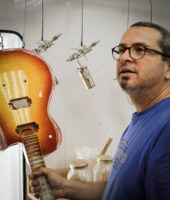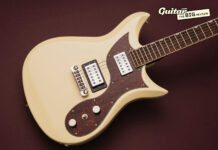
Letters from America: Gil Yaron of Gil Yaron Guitars
Renowned the world over for his unbelievably accurate recreations of golden-era vintage electrics, Gil Yaron now brings a remarkable attention to detail to his own electric guitar creations. Dave Hunter learns about the Israeli luthier’s ‘calling’…
Some things can only be achieved ‘for the love of it’. Whether it’s poetry, painting, or the making of fine hand-crafted musical instruments, the very best work is never done with one eye on the dollars-per-hour ratio. Take the guitars of Gil Yaron, an Israeli luthier who emigrated to Scottsdale, Arizona, in 2015 along with his family. Yaron’s quest to recreate the sound and feel of the most exalted vintage electric guitars involved the sort of investment in his time and personal skill set that could never have been undertaken with any expectation of commensurate compensation—and yet he pressed on, pursued what could only be labelled ‘a calling’, and has delivered hundreds of incomparable instruments as a result.
The Gil Yaron name is likely best known for its appearance on his insanely accurate reproductions of vintage-spec Les Pauls, which are widely considered the finest available at any cost short of a genuine ’59 Burst – as well as his meticulous homages to vintage Fenders. In recent years, however, Yaron has moved on to produce original models exclusively, although these are still entirely informed by the philosophy, skills, techniques, and mountains of data that he accumulated in his pursuit of the hidden secrets of the golden-age electric guitars.
Kid Rock
Having played the guitar from an early age, Yaron also became fascinated with what made the things tick, even before his age had clocked double digits. By the time he’d reached his early teens in the late 70s he had accumulated enough skill to land jobs repairing for local guitar stores near his home outside Tel Aviv, doing what he calls “mainly full-scale repairs and partial builds. So that if a neck needed to be repaired, a headstock, or whatever, I had the tools to do it.”
“That put me on the right track for vintage builds,” he tells us. “Because a lot of the repairs I did were for Fender and Gibson dealerships in Israel, and the customers had some older guitars as well. I gained my reputation pretty quickly and I was very meticulous with what I did, and people loved my work, even though initially they hardly trusted a kid to do the job.”
Following his mandatory military service in Israel, Yaron began his studies at university. At the same time, he was also playing in a band, and the drive to ‘make it’ eventually lured him and his band-mates west. “We moved the band to Los Angeles in ’91,” Yaron relates. “But I had to work because I had no money. I had my experience, though, and even though no one knew me, I got a repair job.
“This was really at the core of the business — Sunset and Gardner in Los Angeles, the junction. It’s pretty much dead today, but it was super alive back in the early 90s when I started there. This was the peak of Guns N’ Roses, and the Seattle sound, and guitars were all over the place. It was crazy. The Les Paul period started with Slash for a while, and he stirred the pot. I started doing a lot of re-tops on Les Pauls, and conversions, and I knew all the people that were in the business back then, the players and so forth. I did most of the work for Guitar Center on one hand, which was a big retail operation, and for Guitarville on the other, which was a little, single-owner vintage-guitar store. It was a great opportunity to put my hands on crazy, expensive, rare Fenders, Gibsons and Gretsches, you name it.”
The Big One
Life in LA was good, Yaron was living the dream – at least as far as the guitarist-turned-first-call-repairman goes – and he was building a reputation among California’s guitar elite… and then the Big One hit. The Northridge Earthquake of 19 January 1994 registered a magnitude of 6.7 and caused massive damage in the San Fernando Valley northwest of downtown LA and the surrounding area. It was a blow from which Yaron couldn’t recover.
“I lost my house, I lost a lot of my stuff, everything got shaky,” he tells us, “and I wasn’t happy staying in Los Angeles any more. Any tremor, I got crazy. I got anxiety, I think. I was just scared, because we got hit really bad. We were almost at the epicentre.”
The shock sent Yaron back to Israel, where his experience in LA landed him at the top of the heap for guitar repair in Tel Aviv, while helping him launch a burgeoning music empire of his own. He purchased a recording studio which he rented out to local bands, and a rehearsal space, and was still playing with his band, Mantra, which by this time had toured with Iron Maiden, among others. “Everything was bigger and bigger,” Yaron says, “and at a certain point I had to make a decision about whether I wanted to still be a musician and tour and all that. The last tour we did was tough, this was hard, and at this point in time I’d had it with music.”
With all else that he had going on, Yaron took a rather surprising about-face from the music business: he returned to university, and earned a degree in software engineering. From there, his progress followed a trajectory you’d expect to see in the bio of any budding Silicon Valley success story, transposed 7,600 miles east: graduates with honours, lands high-paying tech job, develops groundbreaking software, rakes it in on royalties and licensing fees. Until, that is, the guitar bug bit again, and hard.
Full Immersion
“I decided I wanted to go back to guitar building just as a hobby,” Yaron says, “because I was about to retire at a very early stage. I was pretty much economically stable at this point, and I’d got married on the way, we had kids, we’re talking 10 years later. And at this point I really wanted to get back to building guitars. I really needed the smell of wood, the tools, and everything. I built another floor on our rooftop building, which was a beautiful location. You could see the Mediterranean on one side and Jerusalem on the other, you could see half of Israel.
“So I started investigating something that I always had intrigued me, and that was the difference between the older guitars and the newer guitars. I knew vintage, this was my life, the guitars that I played were always older guitars. This was my thing. And I was just trying to answer my own questions, first and foremost. I wasn’t trying to prove a point to anybody, I didn’t want anyone to know what I was doing. It was just a fun thing.”
A contender for understatement of the decade, that “just a fun thing” involved Yaron undertaking an intensive two-year investigation into every discoverable facet of the construction of the great vintage guitars of the 50s and early 60s, and compiling his own massive database to the end of creative perfect reproductions of the vintage Stratocaster, Telecaster, Les Paul, and ES-335. Rather than trying discern the material differences between new guitars and vintage to uncover the inherent magic of the latter, he figured it was a faster road – though a long one – to just build his own guitars as close to vintage as was humanly possible in the late 2000s.
“Then when I was ready to run the Fender line,” he tells us, “I started building guitars just to see the differences, and I have a big collection of originals so I really had the benchmark to A/B to see how I was doing compared to the older stuff, or do the templates correctly and everything else. The results were pretty amazing. It was crazy good.
“Things just went from there. I started building guitars, Teles, Strats, and my friends, players in Israel, they came over and I’d say, ‘Hey, check it out.’ Or I’d take it to some vintage guitar dealers and ask the owners, ‘Hey, what do you think?’ Everybody went kind of crazy over this. It took two or three months for everyone to know about it. I never advertised, it just spread. I got so many emails from people wanting to order guitars, and I didn’t initially want to do this. I just wanted to build guitars for myself just to prove the thing, but I thought, ‘Oh, okay, now I don’t have a pile of guitars that I’m not going to play, I can just sell them! Yeah, let’s clear the house, and I can do more guitars…’”
The Ageing Myth
When asked if he unmasked any long-standing guitar myths during this process, Yaron replies immediately: “The first thing was the claim that the older guitars became better because they got older and they became ‘vintage’. That the wood kind of matured and the lacquer got thin, the pickups got weak. This was a big pile of bullshit from wall to wall. There’s nothing true about any of that. If you go back and listen to the records they used those guitars on back in the 50s and 60s, they sounded pretty awesome back then. You could hear the signature of the old sound back then, so you don’t have to be an expert in building guitars to know that. And I knew that already, to a certain extent, but I wanted to prove a point for myself, and it was very easy to prove.”
So, if not some mystical ageing process, where does that vintage magic come from?
“It’s all about sourcing the lumber in the right places, the same areas that they used to source the wood back then, and you do the exact same everything. The problem is today that you cannot get the old metals or the old magnet wire, or the old lacquer, because the technology has changed, and you pretty much need to remanufacture those things. A big part of the journey was to analyse everything, put it together in a way that I could go to suppliers and say, ‘Can you make me this kind of metal? Can you make me this kind of magnet, or this kind of wire?’ And some would say yes, then ask for minimum quantities that were just impossible to do; we’re talking hundreds of kilograms shipped from wherever. So it took some time just to find the right manufacturers to do stuff.
“Sometimes I had to do the minimum quantity, pay a fortune, and ship maybe a tenth of the stuff. And they were asking me, ‘You just paid for a pile of stuff, what do you want us to do with the rest?’ I’d say, ‘Just throw it away.’ It would cost me so much to ship it, and I have no place to store it, and just a tenth will last me five times my lifetime.”
To the Bone… and Bolt
Toward the early part of the mid 2010s Yaron, along with plenty of other small makers, received a cease-and-desist letter from Gibson regarding his reproduction Les Paul-style guitars. Although he was still in Israel at the time and believed it would have been difficult for the American guitar giant to pursue a lawsuit, he decided that moving away from the vintage body shapes was the right thing to do. As he puts it: “I figured they were right: they own this model, and they own this shape.” The result was his new Bone line of set-neck guitars and Bolt line of bolt-necks, which we might be tempted to describe as ‘entirely original designs’ if he hadn’t revealed to us that the construction of the core models is still entirely informed by their vintage inspirations.
“Everything that is my own model, I cannot take full credit,” Yaron declares, “because for example my Bone ’59 is still pretty much a ’59 Les Paul, with some very small appointments that I change and a slightly different body shape. The truss rod is at the body end to save the headstock, and some other small changes. The core of the sound is still the vintage PAFs, or the Fender early 50s single-coils [on the Bolt models]. The glues are still the traditional hide glue, I still mix my own lacquer with the older materials, all the tools and the manufacturing process, everything is old-school.”
The place where the Bone does achieve some impressive originality of design is in the Bone One model, constructed of a hollowed-out mahogany body ‘shell’ filled with a core of lightweight paulownia wood, capped with flamed maple, and fitted with Yaron’s own Air Gap humbucking pickups, for which he has received a US patent. “I’m not pushing myself, I’m not trying to sell those pickups,” he says of the Air Gaps, “they only come in my guitars and I make only a handful. But I look at those as a huge step in pickup design, because I keep the vintage tone and maybe better, because now you can adjust everything so the pickup balance is perfect. So this is, to me, one of the biggest things I managed to do.”
Otherwise, with his core line-up Yaron feels he is entirely carrying on in a long-established tradition, for which he can take little credit.
“This was not my invention, this was something that had been done by luthiers 300 years ago. They used the same wood, they used the same lacquers. The early Gibson guitars were pretty much old-school, they started as making something that was closer to a violin than an electric guitar, but they still used the same methods. And I do this because I believe this is the right way to build a guitar, not because this is ‘the old way’. The plain truth is that to our ears as players, the old guitars, to some of us, are superior.
“And every guitar I complete, I almost want to cry. When I play it, it’s like the first one I made. I love them so much… I love them. This keeps me going. Maybe one day I’ll grow sick of it and say, ‘Okay, that’s enough. Let’s do something else,’ and I’ll do something else altogether. But this is a love thing still. Otherwise, I think what I do is very simple. There’s not much going on except for just doing it. Building guitars.”The post Letters from America: Gil Yaron of Gil Yaron Guitars appeared first on The Guitar Magazine.
Source: www.guitar-bass.net













